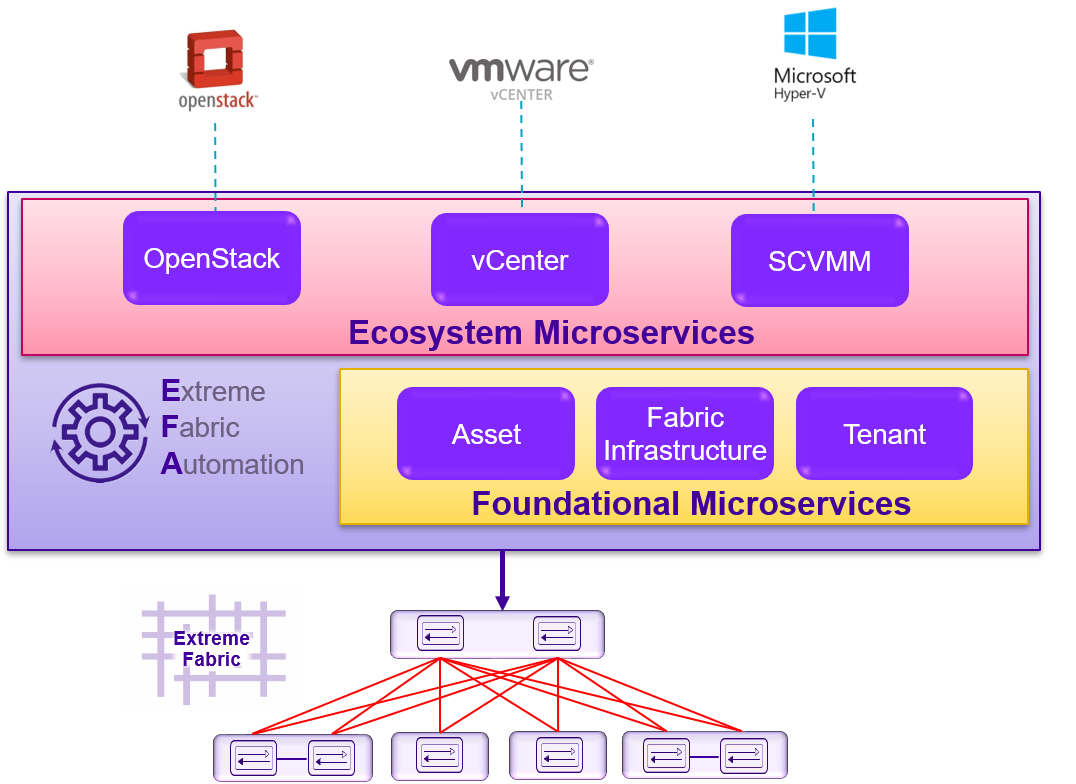Introduction to Extreme Fabric Automation
Extreme Fabric Automation (EFA) is a micro-services-based scalable automation application.
EFA orchestrates the following:
- The life cycle of
- Small Data Center (small DC) fabrics based on Non-Clos topology
- 3-stage or 5-stage IP Clos Fabric
- Tenant-aware Layer 2 and Layer 3 networks
- Integration with ecosystems that
support HCI (Hyper Convergence Infrastructure) Service
- VMware vCenter
- OpenStack
- Microsoft Hyper-V
The key tenets of this orchestration are as follows:
- Conformance to the EVD (Extreme Validated Design) for IP Fabrics: https://www.extremenetworks.com/resources/extreme-validated-design/extreme-ip-Fabric-architecture/
- Speed of provisioning
- Seamless installation and deployment mechanism
- High in performance, low in resource utilization, with minimal touch points
- Programmable containerized services, through an industry-standard Open API (https://www.openapis.org/)-based programmable interface
- Easy-to-use CLI commands to manage devices in an IP Fabric and tenant networks
EFA consists of core containerized services that interact with each other and with other infrastructure services to provide the core functions of Fabric and tenant network automation.
| Asset Service | Provides the secure credential store and deep discovery of physical and logical assets of the managed devices, and publishes the asset refresh or change events to other services. |
| Fabric Service | Helps orchestrate and visualize BGP-EVPN-based 3-stage IP Clos, 5-stage IP Clos and Non-CLOS fabrics |
| Tenant Service | Helps manage the Tenants, Tenant Networks, and end points, fully leveraging the knowledge of assets and the underlying fabric. |
| Inventory Service | Acts as an inventory of all the necessary physical and logical assets of the fabric devices. All other EFA services rely on inventory service asset data for their respective configuration automation. |
| System Service | Provides EFA system utilities such as support-save, backup, and restore. |
| Notification Service | Sends events, alerts, and task updates to external entities. |
| Authentication Service | Enforces a security boundary between northbound clients and downstream operations between EFA and SLX. |
| Authorization Service | Validates users and their credentials. |
| vCenter Service | The vCenter integration provides connectivity between EFA and vCenter using a REST API as documented in the VI SDK. EFA does not connect to individual ESXi servers. All integration is done through vCenter. |
| OpenStack Service | OpenStack is a cloud operating system that controls large pools of compute, storage, and networking resources throughout a data center. |
| Hyper-V Service | The Hyper-V integration supports networking configuration for Hyper-V servers in a data center, manual and automated configuration updates when VMs move, and visibility into the VMs and networking resources that are deployed in the Hyper-V setup. |
The following figure illustrates the application functionality in provisioning and discovery.
Fabric Automation
Microservices


